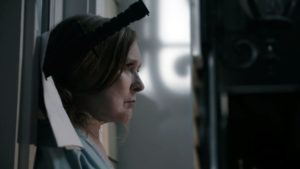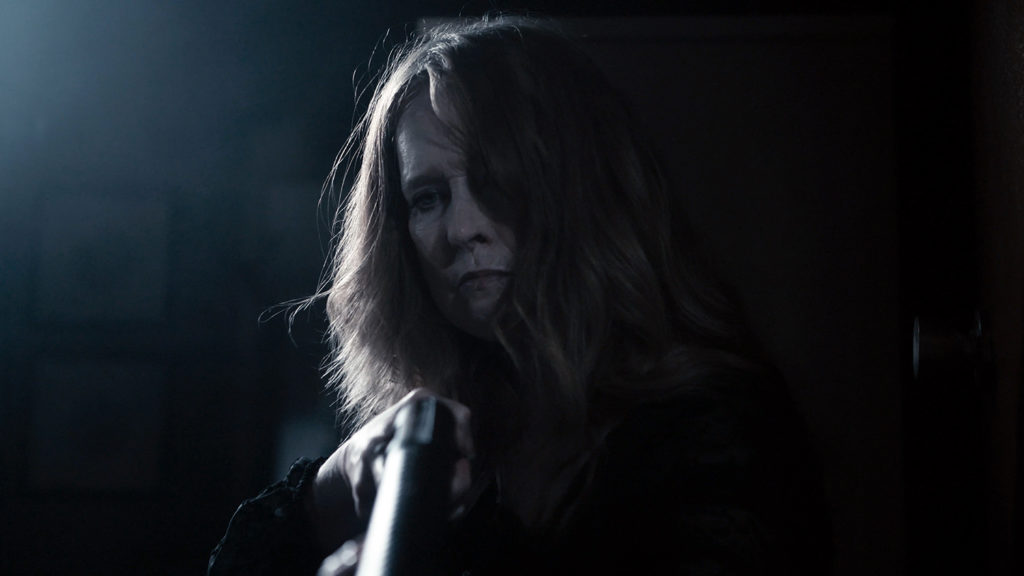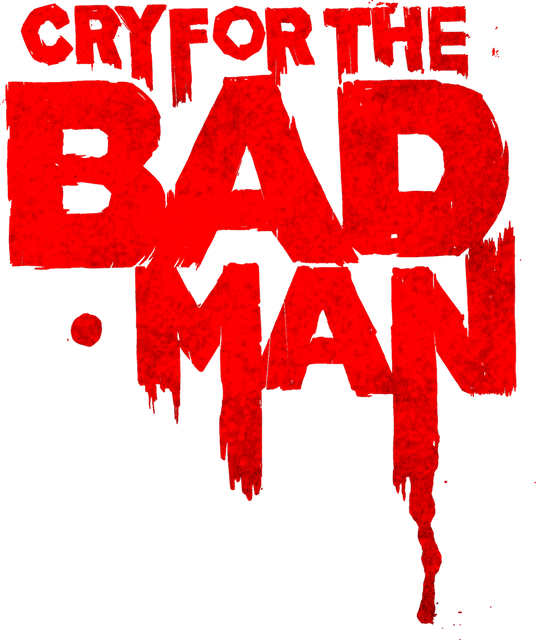Interview with “Cry for the Bad Man” Director Samuel Farmer
Written by: Matt Patti | May 4th, 2020

In the middle of the COVID-19 pandemic’s mandatory quarantine, I had the opportunity to speak with writer-director Samuel Farmer, by phone, to discuss his newest film, Cry for the Bad Man. The film stars Camille Keaton (the original 1978 I Spit on Your Grave) as Marsha Kane, an old widow living alone in the south who is confronted by three local brothers who threaten violence if she doesn’t sell the house to their father, a local land developer. When the county deputy turns a blind eye, Marsha takes matters into her own hands. Soon, a deadly confrontation arises, with Marsha determined to protect her property at all costs. Below is a condensed version of our conversation, edited for grammar, clarity, and length.

Matthew Patti: What was your inspiration for this film? Is it loosely based or maybe slightly inspired by any real-life events or real people?
Samuel Farmer: The short answer is it was more pragmatic. When we had a limited budget, we pitched an idea to Camille Keaton and she accepted it based off of what she was interested in and what we knew we’d be able to accomplish with minimal resources. That said, I haven’t really talked about this, but at the time that we worked on it I was a producer at a PBS station down here and I had pitched an idea for a docu-series called “Soft Target,” which was about violence against women, specifically here in the city of Jacksonville. Jacksonville had been experiencing a spike in murder at the time, and violent crime. And interestingly enough, apropos to this lockdown, Duvall County right now is experiencing another spike in crime despite the shelter-in-place order, which is weird.
I was working with another journalist at the time and we had put together a pitch, and leadership changed at the station that I was at. And long story short, senior staff loved the pitch and then they decided not to fund it. So we had just months of just bad mojo, all these terrible stories. And in the middle of all that, I read this story about this woman named Sarah Don McKinley. It’s not based on her; it was just kind of a moment of inspiration. I think she was 19 at the time. She had married an older man. They had a child together. He died suddenly of a heart attack and one night some creep tried to break into the house. And there’s a 9-1-1 call out there on the internet of this woman basically saying “Hey, somebody is trying to kick my door in. I’m here with my infant child. You know, I’m alone. I’ve got a gun. If he comes in, am I allowed to shoot him?” and basically a 9-1-1 dispatcher says, “I can’t tell you it’s okay to shoot somebody, but do whatever you have to do to protect the kid.”
Long story short, the guy came in and she shot him. And that was the end of that. And I think that was on my mind at the time. Just the idea that someone would view this person as defenseless and alone and that this woman would be a pushover, “This will be easy.” So that attitude, I think, inspired the bad guys in the movie, just thinking there’s an older woman out by herself, this will be a piece of cake.
MP: Seemingly everyone Marsha encounters in the film strongly believes she should take the money, sell her house, and leave town. Yet, Marsha is very stubborn and will not give it up. Why do you think Marsha is so hell-bent on keeping a house in a town where it seems that nobody but her daughter cares about her?
SF: I don’t know, it’s the kind of thing if you’ve ever dealt with someone 70-plus, there’s a kind of “set in their ways” mentality that sometimes feels maybe irrational at times. I honestly don’t know what inspires it. It’s conversations that I’ve had with my grandmother and other people where there just seems to be this thing rooted in tradition, especially down here in the south where people just don’t want to let go of things no matter how seemingly arbitrary it is. We tried to give a little bit more gravity and a little bit more meaning to it with the character, and I think there’s even a line in the film where she says that she built a house there. I don’t know if we were trying to make a statement or whatever, but there’s a moment where she says to her own daughter “everybody assumes, more or less, that my husband built this house and I can’t let go of him. And that’s what the house represents. But I built this house; I wasn’t just the housewife serving iced tea to this guy while he built the house, this is my house.” And there’s some pride in that.

We did, I will say this, we didn’t get a chance to shoot it, but there was an additional scene. It was just cost prohibitive to actually shoot it, where in the end she does take the money. It was supposed to be like the final middle finger. Like she was sort of over it, you know, after the conflict, you’d finally get to meet the sheriff and realize why the deputy had been basically preventing any of this from getting out. So none of the reports had ever been filed and everything was dirty from that and the sheriff was going to be a woman. Long story short, the final insult was going to be, they brought a contract for her obviously, and you see it throughout the film that she was just going to sign it. And so the middle finger is, you know, you’ve killed your kids and I’m going to take that quarter million dollars you offered for my house and split town, like the last insult to Bill Sr. But we just didn’t have the money and it seemed appropriate to just end it where it was.
MP: So that sort of leads me into my next question. The sequence of Marsha guarding her home from the three brothers begins right before the halfway point of the film. Was it always the plan to get to the main confrontation that early, or was there more set-up originally planned?
SF: We’ve been trying to make this movie for about seven years. There was an older version of the script where there might’ve been just a little bit more time, but once the conflict began, the idea was always to kind of keep it in real time as much as possible from that point on. So, we definitely wanted, from the first gunshot until the last gunshot, there to be this sense that this was all unfolding on screen as you’re watching it and that we weren’t cheating and jumping ahead. So, yeah, more or less.
MP: You mentioned earlier about your inspiration kind of being from that 9-1-1 call and the woman asking the operator if she can shoot this person. Marsha seems to also be willing to do whatever it takes to guard her home. She explains to Wayne that she’s operating under “Castle Law.” However, do you think Castle Law would still apply to the full range of Marsha’s actions?
SF: That was something that also would have been addressed in the last scene. The short answer is no. The long answer is, we had a scene where I was inspired honestly by Deliverance a little bit. And I think one of the most underappreciated aspects of Deliverance is the final act of the film where they’re out of the woods and now they have to deal with “Shit, we survived, but we still live in a society with laws.” And there’s a moment where it doesn’t matter how put upon they were, what they endured, that they’re really on the hook for becoming criminals. There was a quote, I don’t know who said this and I’m paraphrasing, but it was “revenge makes criminals of victims” and that’s kind of the attitude that we took that the audience would probably be on her side, but at some point, you would have to face up to it.

A lot of it, Wayne kind of spells out for her in his speech, like, “You shot at us first. We didn’t show up here armed. You could make a case that we were harassing you, but …” There’s a reasonable case to be made that there is a bit of overkill to some of it, particularly when she shoots the deputy for walking into her house without a warrant. So, the ending scene was supposed to be a moment of understanding from this sheriff that the sheriff understood what had transpired here and that it wasn’t all above board, but because this woman had to deal with this, basically because of corruption in the small-town Sheriff’s office, that she was going to kind of look the other way. You know, it’s kind of like the end of Deliverance or the end of a great Western. It’s like, I want you out of town by sundown. I’m not going to do anything. You won’t be in trouble. You’re not going to end up in jail. But you know, you get out of here basically.
MP: There’s a flashback near the end of the film showing Marsha and her now deceased husband. What was the thought on placing it at that point in the film, and what effect do you think reflecting on it at that time had on Marsha?
SF: So that was an addition. Just so you know, we went through the film and we knew that there was more to Marsha than just a lonely widow. We wanted to show her with some dirt, basically. There’s a mugshot in the film and an implication that she probably had a rowdy youth. She’s not just this old woman who’s going to lie down. The reason that we stuck that part in was we felt like we knew the back story wasn’t super important. Like there’s no reason to dwell on it or who she was. As far as I’m concerned, when the guys knock on the door, that’s the beginning of the story. We felt like there was an opportunity to show that.
She had to do this incredibly difficult thing, which is, you know, we’re down here in Florida, we’re down here in the South and there’s no right to die down here. And people end up in situations obviously where they’re suffering, their quality of life has gone and we thought that it would be a particularly painful thing to have to watch her do, to put someone down like that especially someone she cared about, someone who couldn’t do it themselves. And we put the flashback part in that specific spot to juxtapose it against the fact that the main bad guy, his youngest brother is dying, and he refuses him mercy, it’s a more sociopathic moment in the film where he just sees his suffering, sees that he’s unable to put himself out of his misery and just flatly refuses it. And that triggers that moment in Marsha’s mind where she had to do a similar thing. So I wanted there to be this obvious gulf between these two characters where you could see one did it out of compassion and the other one is just callous and has no concern for his own brother.
MP: Any time Marsha’s phone gets a text it appears on the counter upside down. What was the basis of the choice to have the phone screen be shown upside down, yet still readable?
SF: Honestly, nothing. We did some of that in post, I think. I don’t even think that the text was in the script. I think there was a phone call at one point in the script. But we just felt like two things: one, Helen would be worried after her last interaction with her mother and probably be checking in more and more; and two, this is true of Camille in real life. I’ve known her for several years at this point and I text her quite often. She is someone who in the middle of something important would just set a phone down and completely forget about it, and it just seemed like an appropriate character attribute that in the middle of this siege, like if you’re really concerned, you left in a really uneven note with your daughter, she’s worried about your mental state. If you want to keep her away, you should probably at least send out a signal that everything’s fine, stay away, you know?

But basically when Helen showed up later, we didn’t want it to seem like, Hey, why is she showing up at midnight? We wanted there to be some indication to the audience that she’s been trying to check in on her for hours and she’s not hearing anything. So it comes to that she’s going to go back out to check in on her. But there was no logic in having it upside down. We shot everything in the studio, like a lot of the inserts were done in a studio, after production ended. So we just stuck it upside down.
MP: The first musical theme of the film during the montage of Marsha cleaning up after her husband’s death sounds much like the main theme of the Halloween films. Was this a bit of a tribute, or merely a coincidence?
SF: It’s interesting. There are two versions of it out there right now. I know which one you’re talking about. The composer, Franko Carino, I gave him a handful of musical references and one of them was Halloween, but it was Halloween III. It wasn’t actually that original, and it was just kind of like, you know, this is broad. I gave him some Steve Moore and I think some John Carpenter and I said, “Do your thing.” Turned him loose on it. Didn’t micromanage. I just waited for him to turn it into a soundtrack. But yeah, I picked up on that too when it came through. I thought that it felt very reminiscent of that theme. But yeah, it’s funny, or I guess curious, that that’s what it sounds like, the one that I gave him was from the third film, which doesn’t sound like that at all.
MP: Thank you so much for your time. I appreciate it.
SF: No, thank you. I appreciate the call. Thanks for checking out the film, too.

